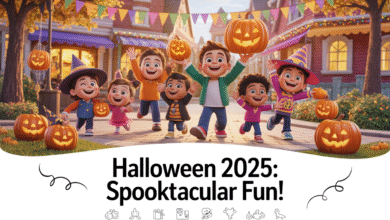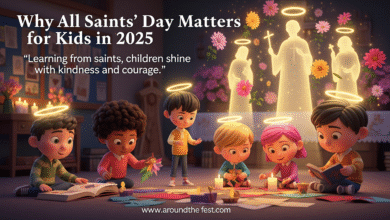Thanksgiving Day 2025 in the USA: History, Traditions and More
Introduction: Thanksgiving Day 2025 in the USA
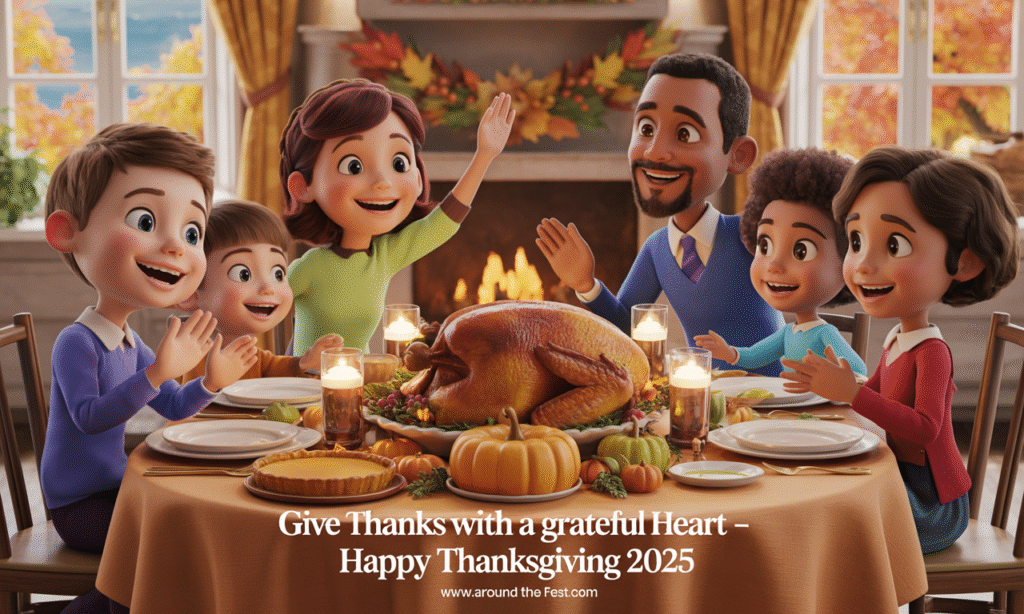
Thanksgiving Day 2025 in the USA is more than just a date on the calendar. It’s one of the most cherished national holidays—a celebration that blends history, tradition, and modern cultural shifts. Falling on Thursday, November 27, 2025, this year’s Thanksgiving is set to be one of the most anticipated holidays of the season. Families will gather, old customs will be honored, and new traditions will reflect today’s diverse American lifestyle.
The Origins of Thanksgiving
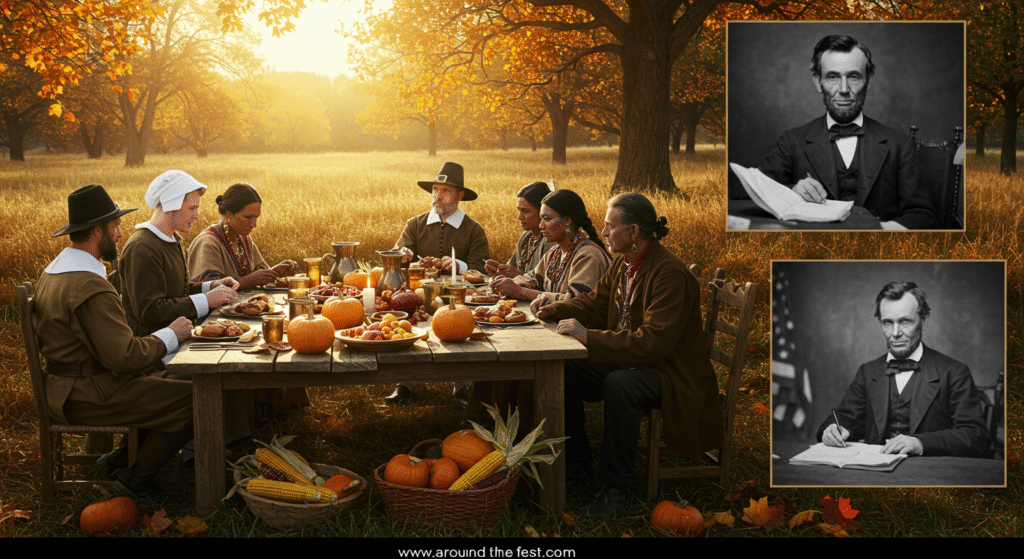
At its core, Thanksgiving has always symbolized gratitude, unity, and community spirit. Its origins go back to 1621, when the Pilgrims and the Wampanoag people came together for a harvest feast. That moment became a powerful symbol of cooperation and thankfulness.
Later, in 1863, President Abraham Lincoln officially declared Thanksgiving a national holiday during the Civil War. He framed it as a day of healing and togetherness for a divided nation. What began as a harvest celebration has since transformed into a holiday that resonates deeply with every generation of Americans.
Classic Traditions That Endure-Thanksgiving Day 2025 in the USA
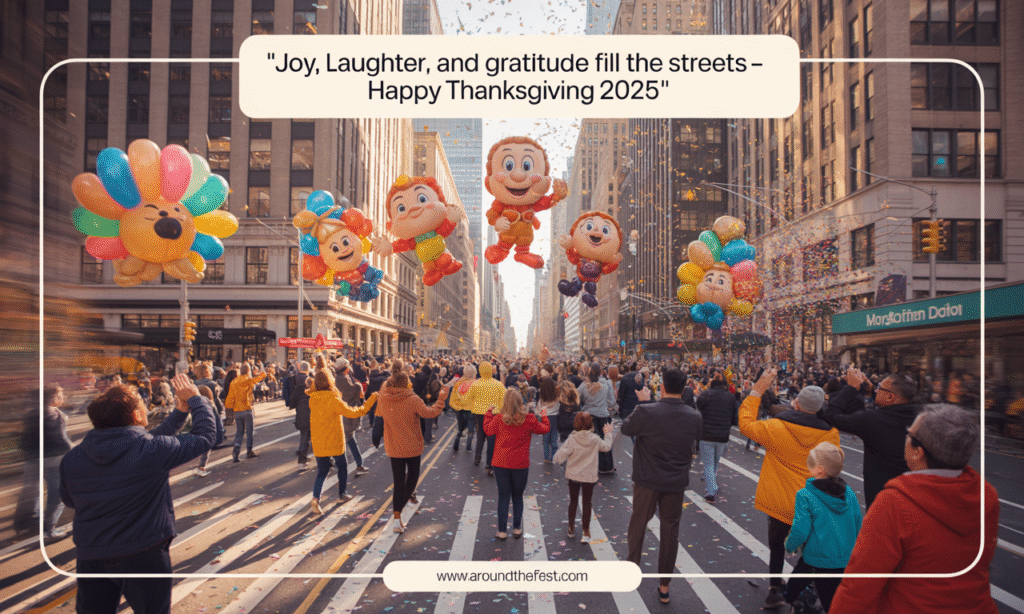
In 2025, Thanksgiving still revolves around the classic feast. Turkey, stuffing, cranberry sauce, mashed potatoes, and pumpkin pie remain staples on most tables. Beyond the food, the holiday is also marked by iconic traditions such as the Macy’s Thanksgiving Day Parade, NFL football games, and countless acts of kindness through volunteering and community service.
New Ways of Celebrating Thanksgiving
While many keep to long-held customs, new practices are reshaping the holiday. Friendsgiving dinners, plant-based feasts, and multicultural menus reflect America’s ever-expanding cultural mosaic. These modern traditions highlight how Thanksgiving continues to evolve while honoring its roots.
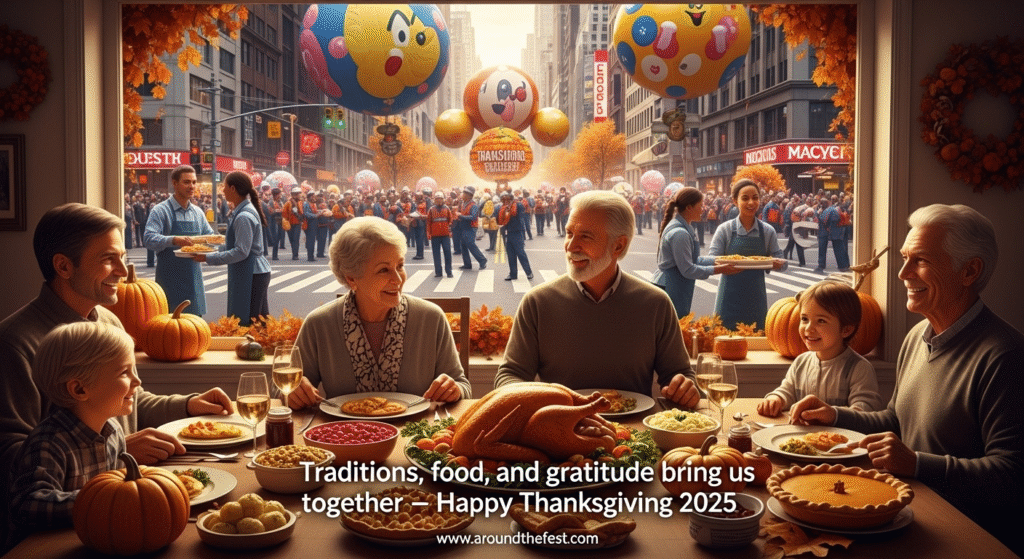
Thanksgiving in a Changing World
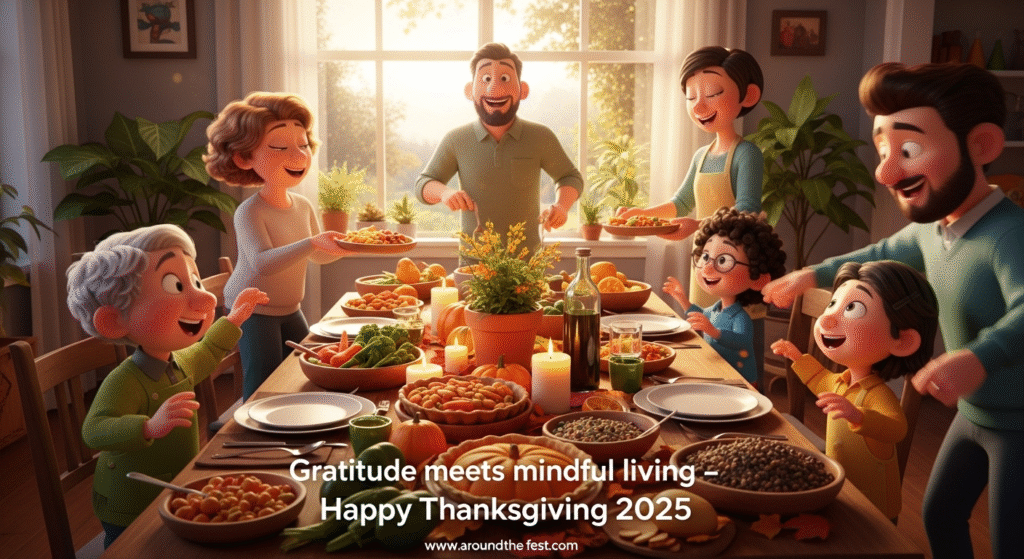
What makes Thanksgiving Day 2025 unique is the growing awareness of how Americans celebrate in today’s world. Families are practicing sustainable traditions by reducing food waste, sourcing local produce, and choosing eco-friendly décor. Others are setting “tech-free hours” during dinner to ensure loved ones are truly present in the moment.
These evolving practices show how the holiday stays relevant in an age defined by fast-paced lifestyles and digital distractions.
History of Thanksgiving Day in the USA
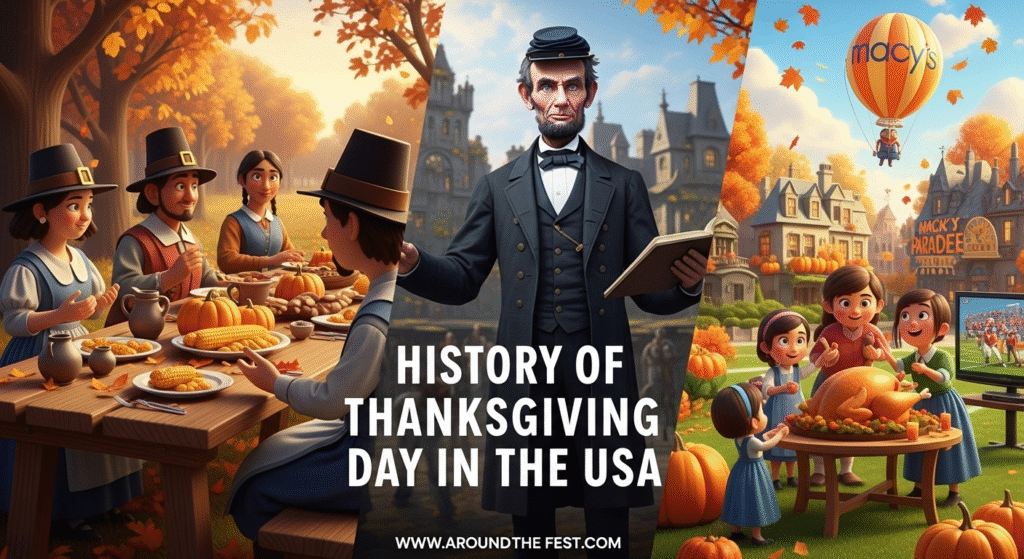
The history of Thanksgiving Day in the USA is richer than the simple picture of Pilgrims and turkeys found in schoolbooks. At its core, the holiday blends Native American traditions, colonial survival stories, and evolving American values into a national celebration of gratitude.
From the 1621 harvest feast to today’s multimillion-viewer parades, the journey shows why Thanksgiving remains one of the most enduring holidays in America.
The First Thanksgiving of 1621
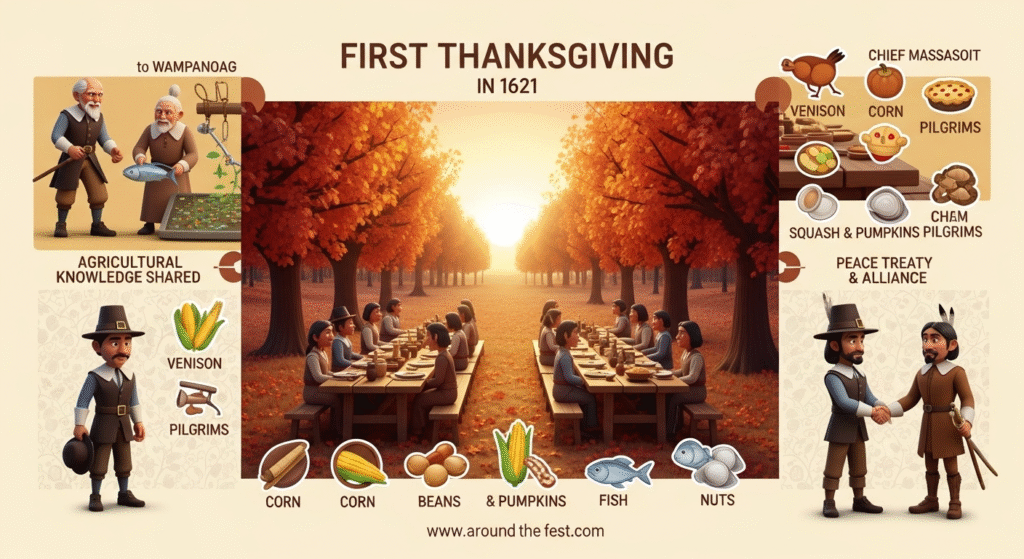
The first Thanksgiving story often highlights the Pilgrims who landed at Plymouth Rock. Equally important were the Wampanoag people, whose agricultural knowledge helped the struggling newcomers survive.
The harvest feast of 1621 wasn’t just about turkey and corn. It included venison, wild fowl, beans, squash, and other Indigenous crops. This meal reflected a fusion of Native and European food traditions.
What made the moment unique was more than food. It represented cultural exchange. The Wampanoag taught the Pilgrims how to use fish as fertilizer and rotate crops. Without this guidance, the colony might not have survived.
Modern historians note that while this three-day gathering is often mythologized, it set a precedent for gratitude as a survival practice. The lesson remains relevant today as communities look to resilience in the face of global challenges.
The Pilgrims never called this feast “Thanksgiving.” For them, it marked survival after a brutal winter in which nearly half their group perished. Chief Massasoit and the Wampanoag played a key role in teaching farming, fishing, and land-based survival.
This event wasn’t pure unity—it was also a fragile alliance. The meal likely featured venison, seafood, nuts, corn, beans, and squash, far from the turkey-and-pie image we imagine today. It symbolized both cooperation and the start of a complicated history between colonists and Indigenous people.
Unique insight: Historians suggest that for the Wampanoag, the feast was less about joy and more about diplomacy. It was a way to maintain peace with newcomers who could pose future threats. Thanksgiving in 1621 was about gratitude, but also resilience and negotiation.
Abraham Lincoln and the National Holiday
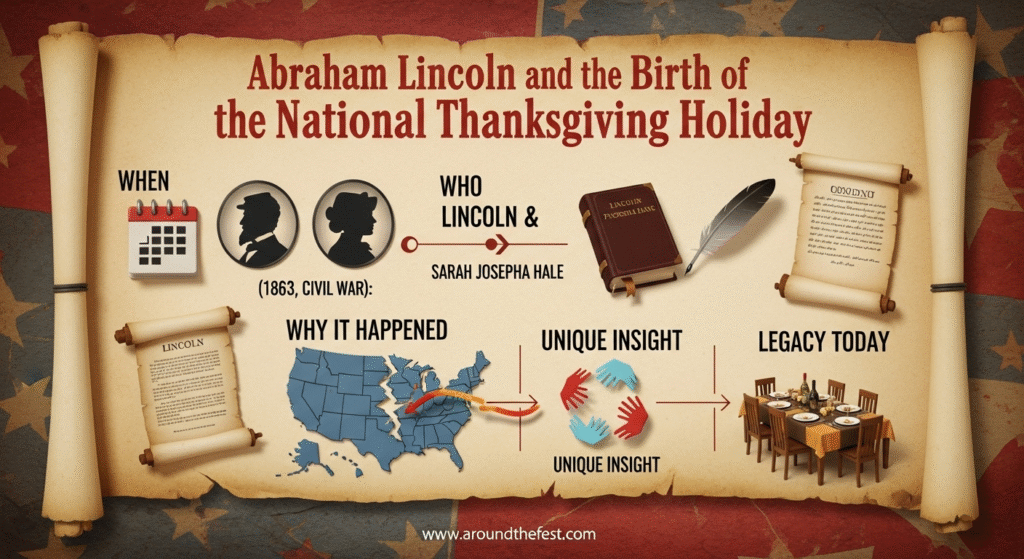
Two centuries later, Thanksgiving became a formal part of American identity. During the Civil War, Lincoln’s 1863 Thanksgiving Proclamation sought to mend a divided nation by declaring a shared day of gratitude.
Sarah Josepha Hale, editor of Godey’s Lady’s Book and author of “Mary Had a Little Lamb,” spent nearly 20 years campaigning for Thanksgiving to be recognized nationally. To her, Thanksgiving was more than a feast—it was a chance to soften animosities tearing the country apart.
Lincoln reframed Thanksgiving as a national ritual of reflection and gratitude during one of America’s darkest times. His proclamation turned scattered regional observances into a single, enduring tradition.
At the height of the Civil War, the holiday gave Americans a pause for gratitude. Lincoln, influenced by Hale’s 17-year campaign, envisioned Thanksgiving as a tool for healing. It wasn’t just about harvest or food. It became a unifying tradition, bridging divides during crisis.
This marked the first presidential declaration of Thanksgiving as a holiday. Lincoln framed it as a day of prayer, reflection, and unity.
Unique insight: Few realize Thanksgiving was also an early form of cultural branding. It stitched together a fractured nation by giving everyone a common ritual. The holiday’s survival owes as much to political strategy as to cultural memory.
Evolution of Thanksgiving in American Culture
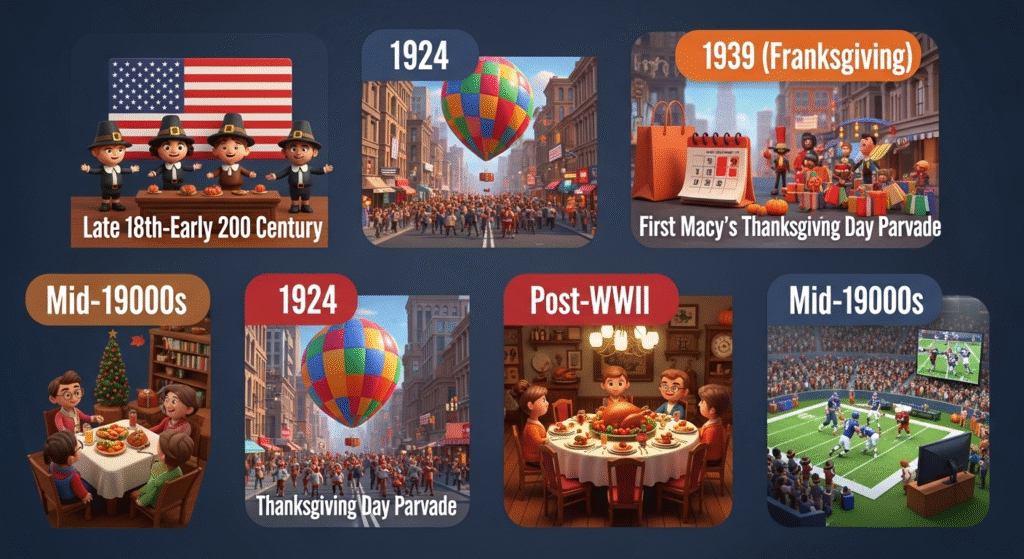
The evolution of Thanksgiving mirrors the changing face of American society. In the late 19th and early 20th centuries, parades, pageants, and school plays popularized the Pilgrim story. They taught patriotism and identity to new immigrants. The holiday became a tool for weaving together a diverse population.
Key Milestones in the 20th Century
1924: The first Macy’s Thanksgiving Day Parade debuted in New York City. It turned the holiday into a nationwide spectacle.
1939: President Franklin D. Roosevelt moved Thanksgiving a week earlier to extend the shopping season. The change, nicknamed “Franksgiving,” tied the holiday closer to consumer culture and paved the way for Black Friday.
Post-WWII: Thanksgiving became a symbol of prosperity. Wartime rationing had established turkey as the main dish. After the war, turkey dinners became inseparable from the holiday.
Thanksgiving Expands Beyond the Table
Over time, Thanksgiving spilled beyond dining rooms into streets, stadiums, and stores. Football became a central tradition, both in stadiums and living rooms. By the mid-1900s, Thanksgiving marked the official start of the holiday season, blending family, faith, entertainment, and commerce.
During WWII, soldiers overseas received turkey dinners as a morale booster. This gesture helped connect them to home and showed the holiday’s role in national identity.
Thanksgiving in Modern Times
Today, Thanksgiving continues to adapt. Families embrace global food traditions, Friendsgiving gatherings, and eco-conscious practices like reducing food waste or buying local produce. The holiday evolves with each generation, keeping it relevant.
Thanksgiving stands out among American holidays because, while traditions shift—from feasts to parades, football, and shopping—the heart remains the same. It is a collective pause for gratitude. From the Pilgrim story to eco-conscious dinners, it adapts to changing values while offering a cultural “pause button” in fast-paced American life.
Traditions of Thanksgiving Day in the United States
Thanksgiving Day 2025 in the USA is marked by timeless traditions that combine food, family, parades, football, and acts of gratitude. These American holiday rituals are deeply rooted in history, yet they continue to evolve with modern twists that reflect the country’s diverse culture. From the first harvest feast in 1621 shared between the Pilgrims and the Wampanoag people to today’s televised NFL games and giant balloon parades, Thanksgiving heritage blends both old and new customs into one beloved holiday.

Family Gatherings and the Thanksgiving Feast in the USA 2025
The Thanksgiving table still takes center stage in 2025, anchoring the holiday across the United States. While roast turkey is the star of most holiday dinners, the regional flavors tell a fascinating story of American holiday customs:
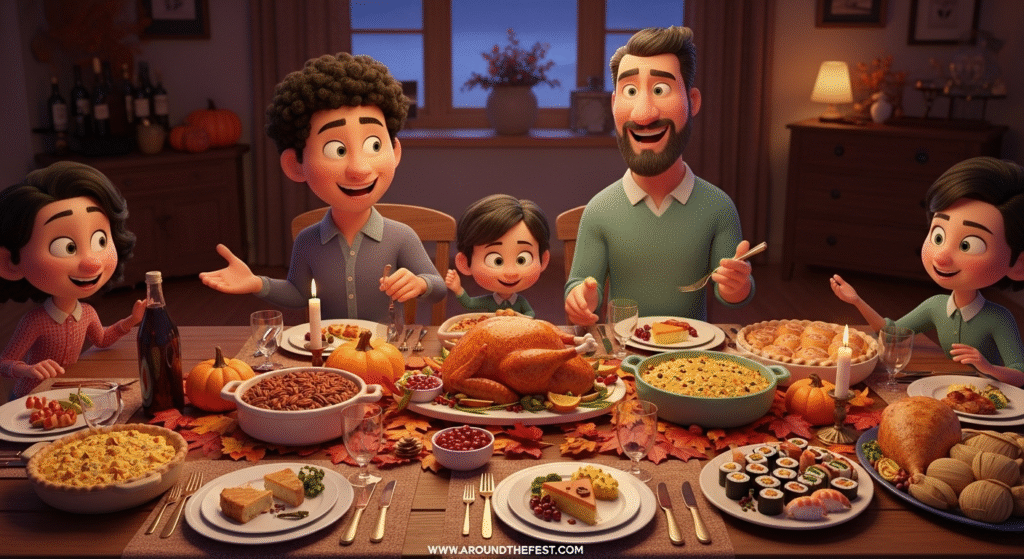
New England: Traditional cranberry sauce and pumpkin pie — dishes that echo back to colonial harvests.
The South: Cornbread dressing, collard greens, and pecan pie, rooted in both Native American corn traditions and African culinary influences.
The Midwest: Hearty casseroles and fluffy butter rolls, reflecting the agricultural abundance of America’s “breadbasket.”
The West Coast: Multicultural menus featuring vegan options, tamales, sushi platters, and plant-based turkey alternatives.
Historical Tradition: The idea of the “family feast” grew popular in the 19th century after Abraham Lincoln’s proclamation in 1863, when he encouraged families to gather and give thanks despite the Civil War.
Fresh Insight 2025: More households are turning toward plant-based turkey alternatives, with U.S. sales of meat substitutes projected to reach $3.6 billion by the end of 2025.
Thanksgiving Day Parades Across America in 2025
Though the Macy’s Parade in New York dominates TV screens, the 2025 parade tradition spans the nation, with other celebrations just as integral to Thanksgiving’s legacy.
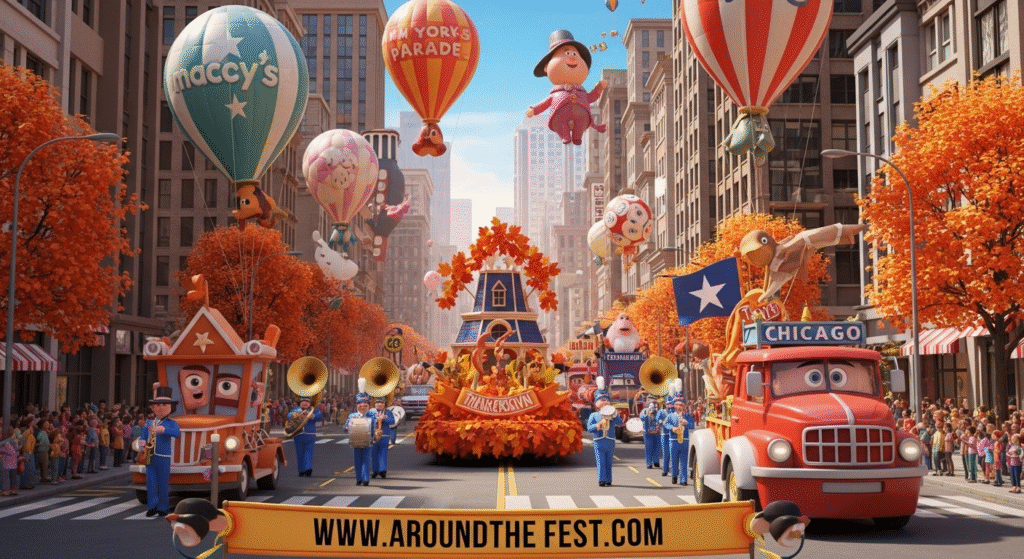
Philadelphia’s parade—first held in 1920—remains the oldest Thanksgiving tradition of its kind.
Chicago’s Thanksgiving Parade — celebrated for its towering balloons and Broadway-style performances.
Houston H-E-B Parade – A Texas-flavored tradition with classic floats and local pride.
Historical Tradition: Parades first gained popularity in the early 20th century as community celebrations, blending marching bands, festive floats, and local businesses. Over time, they came to mark the start of the holiday shopping season.
Modern Twist: In many small towns, “Turkey Trots” (fun runs held on Thanksgiving morning) are replacing parades, showing how Thanksgiving Day 2025 in the USA adapts to local lifestyles and fitness trends.
Football and Sports Traditions on Thanksgiving Day 2025
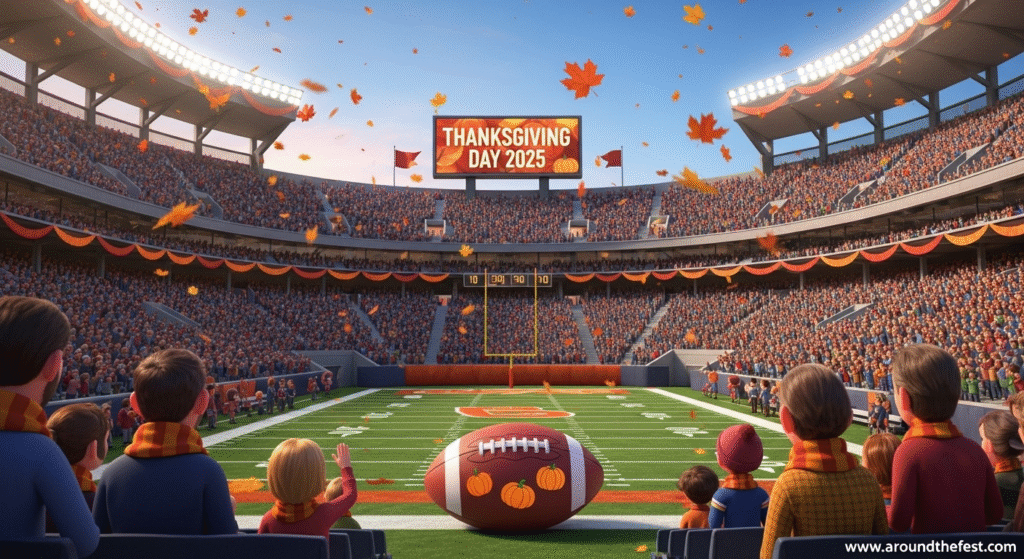
Football is one of the most enduring Thanksgiving Day traditions in the USA. Since 1934, NFL games have been a staple of the holiday schedule, with the Detroit Lions and Dallas Cowboys continuing their annual matchups. The Thanksgiving NFL games 2025 are set to keep this ritual alive.
High School & College Rivalries: Beyond the NFL, local Thanksgiving rivalry games are cherished in towns and cities across America, often drawing bigger crowds than regular season matches.
Historical Note: The Detroit Lions hosted the first official NFL Thanksgiving Day game in 1934, cementing football as part of the Thanksgiving holiday heritage.
Acts of Gratitude, Charity and Volunteering in Thanksgiving 2025
At its heart, Thanksgiving Day 2025 in the USA is not just about feasts and football — it’s about gratitude. Acts of giving back have become a core part of American holiday rituals:
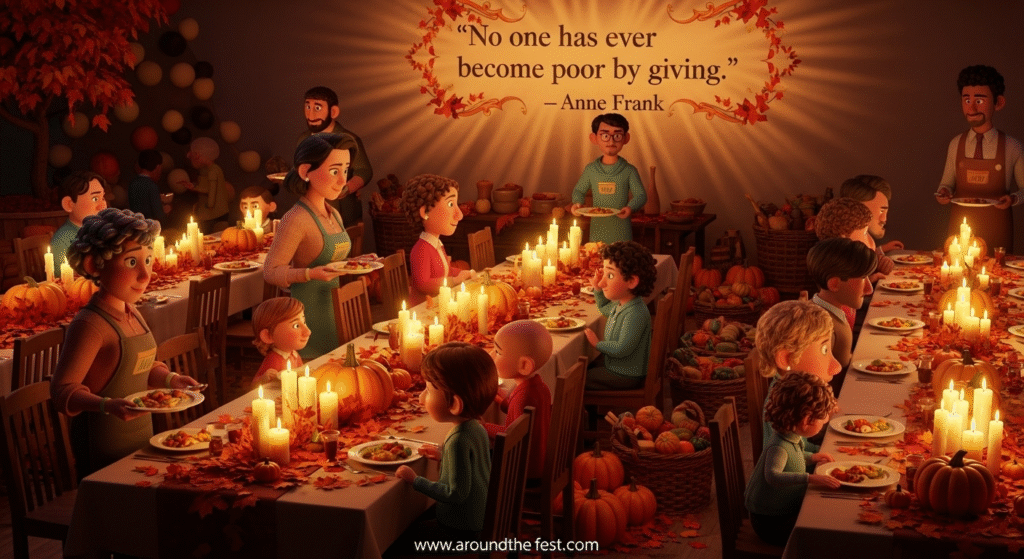
Food Banks: Record donations pour in during Thanksgiving week.
Community Meals: Churches, shelters, and nonprofits host dinners for the less fortunate.
National Impact: In 2024, Feeding America provided meals to over 45 million people during the holiday season.
Historical Tradition: Even in the earliest harvest festivals, gratitude was expressed through sharing food with others. Over the centuries, this evolved into organized volunteering and charity drives, keeping the spirit of unity alive.
Forgotten Thanksgiving Traditions: Ragamuffin Day, Presidential Turkey Pardons, and Harvest Sermons
While modern Americans associate Thanksgiving with turkey, parades, and football, earlier eras celebrated the holiday with customs that have faded from the mainstream:
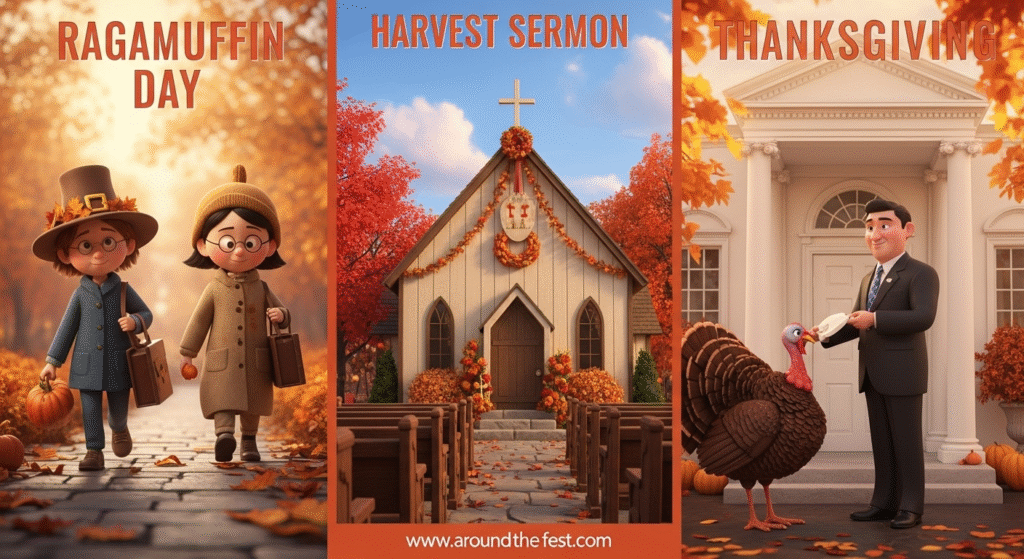
Ragamuffin Day: In the late 19th and early 20th centuries, children in New York dressed in costumes on Thanksgiving, going door-to-door for treats — a practice that resembled modern-day Halloween.
Harvest Sermons: Churches once held special sermons dedicated to gratitude for the year’s harvest, linking the holiday more closely with its agricultural roots.
The Presidential Turkey Pardon: First formalized in the late 20th century, this quirky White House tradition of “pardoning” a turkey remains symbolic, though far less central to family celebrations.
These forgotten traditions remind us that Thanksgiving Day 2025 in the USA is part of a long, evolving story — one where rituals change, but the spirit of gratitude endures.
Friendsgiving: The Rise of a Modern Thanksgiving Tradition 2025
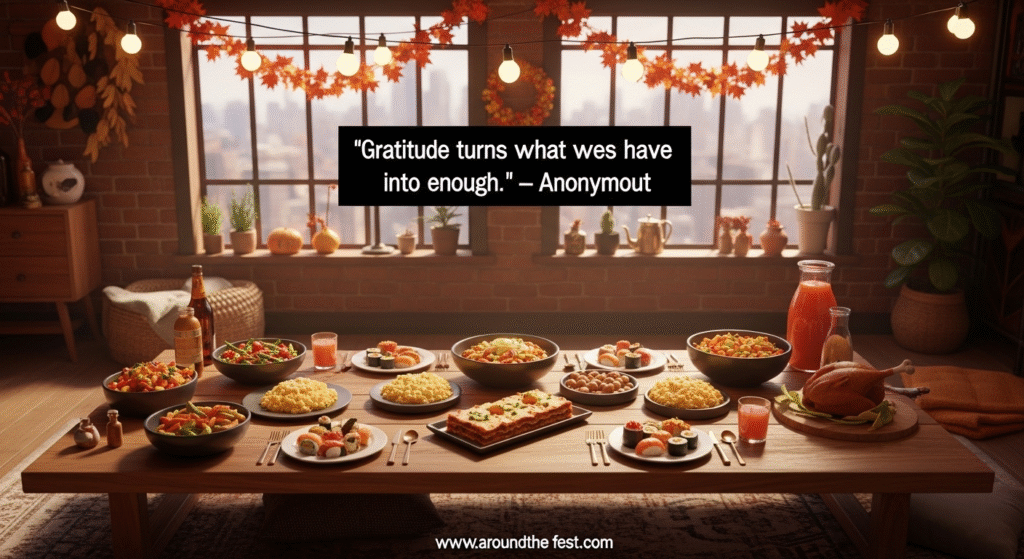
Picture this: a cozy apartment filled with mismatched chairs, laughter spilling over the clink of glasses, and a turkey sharing the table with mac & cheese, sushi, and maybe even a vegan lasagna. This isn’t your grandma’s Thanksgiving—it’s Friendsgiving, the holiday’s modern cousin.
Not every Thanksgiving celebration happens at the family dinner table. Over the past few decades, Friendsgiving has become a beloved offshoot of the holiday. Typically held the weekend before Thanksgiving, it’s a time when friends—often young professionals, students, or those living far from family—host their own feast.
The idea first started appearing in the 1990s and early 2000s, partly boosted by popular sitcoms like Friends, which showcased Thanksgiving gatherings filled with laughter, mismatched traditions, and quirky menus. By the 2010s, social media turned Friendsgiving into a cultural movement, with hashtags, viral recipe swaps, and themed potlucks making it mainstream.
Menus are often more experimental—tacos, mac & cheese, vegan spreads, or even global cuisines like sushi or tamales. The vibe is relaxed compared to the formality of a family dinner. In many ways, Friendsgiving reflects the true heart of Thanksgiving: community, gratitude, and chosen family.
Eco-Friendly & Zero-Waste Thanksgiving Feasts

Now, imagine a Thanksgiving table where the turkey is farm-raised just miles away, the cranberry sauce comes from a local market, and every plate, napkin, and fork is reusable or compostable. Welcome to the rise of the eco-friendly Thanksgiving.
In 2025, many households are adding a green twist to their celebrations. With climate awareness rising, eco-conscious traditions are gaining popularity:
- Choosing locally raised turkeys or plant-based mains.
- Reducing food waste by donating leftovers or repurposing them into creative dishes.
- Choose compostable or reusable serving ware in place of disposables.
- Supporting local farmers’ markets instead of big-box stores.
- Decorating with natural, compostable materials like leaves and pinecones.
Historically, this trend ties back to Indigenous harvest practices. Native communities across North America lived by principles of seasonal eating, gratitude to the land, and sustainable farming—values that echo in today’s eco-conscious choices. In this sense, the “green Thanksgiving” is not a new invention but rather a return to older traditions of balance with nature.
By blending sustainability with gratitude, families are reshaping Thanksgiving into a holiday that honors not only relationships but also the planet that sustains them.
Modern Thanksgiving Celebrations in the USA (2025)
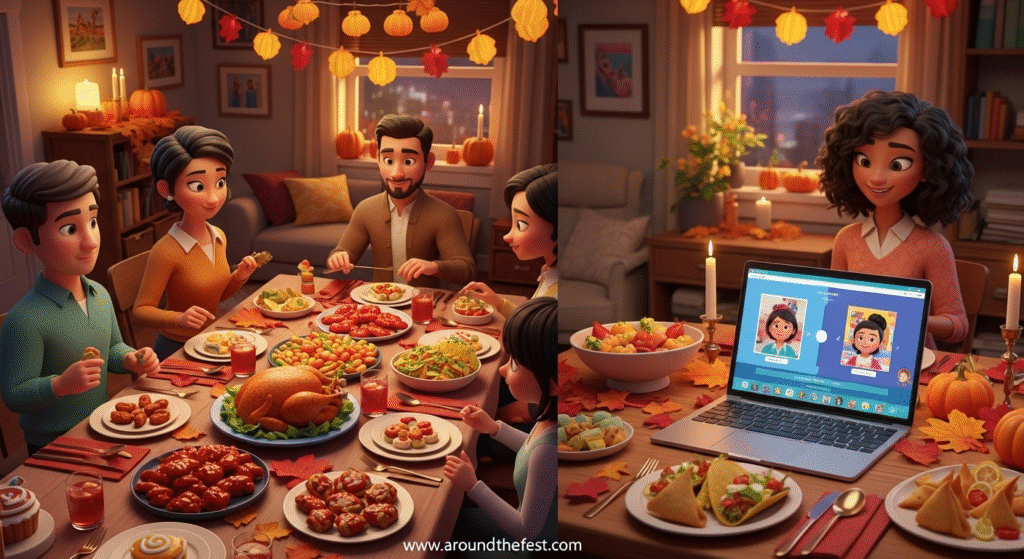
Thanksgiving in the USA has always been about gratitude, family, and food, but in 2025 the holiday continues to evolve in fascinating ways. Beyond the traditional turkey feast, Americans are reimagining how they celebrate, influenced by technology, global connections, and lifestyle shifts. From the rise of Friendsgiving to digital reunions and eco-conscious feasts, Thanksgiving is no longer one-size-fits-all—it reflects the diversity and creativity of modern American life.
Friendsgiving: The Rise of a New Tradition
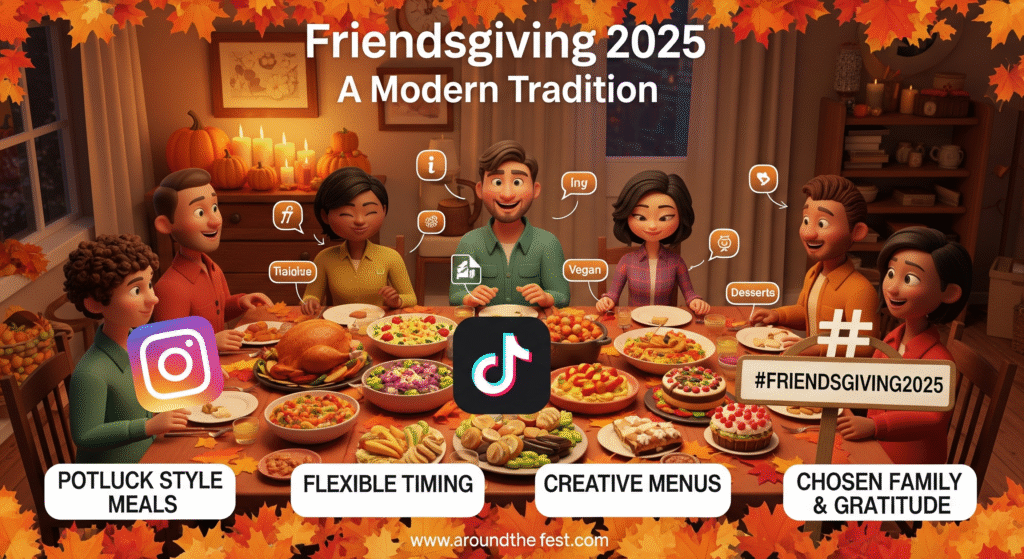
Thanksgiving in the USA traditionally evokes images of family reunions around a large dinner table. However, in recent decades, a new cultural twist has emerged—Friendsgiving, a blend of “friends” and “Thanksgiving.” While not an official holiday, Friendsgiving has grown rapidly, especially among younger generations, and by Thanksgiving 2025, it is no longer just a casual trend—it has become a firmly established part of the holiday season.
Friendsgiving celebrates chosen family—friends, roommates, and coworkers—often gathering before or after the official holiday. Unlike traditional family-centered feasts, Friendsgiving emphasizes flexibility, creativity, and inclusivity.
You May Also Read –https://aroundthefest.com/where-to-celebrate-diwali-2025-india-abroad/
Origins of Friendsgiving
- 1990s – TV shows like Friends inspire the idea of celebrating Thanksgiving with friends.
- Early 2000s – The word Friendsgiving begins circulating among college students and young adults.
- Late 2000s – Social media helps the term gain popularity.
- 2011 – Baileys Irish Cream launches the first major Friendsgiving ad campaign.
- 2013 – Target uses “Friendsgiving” in holiday marketing, cementing it in pop culture.
- 2020s – Friendsgiving is recognized in dictionaries and lifestyle media as an official holiday trend.
- 2025 – Friendsgiving is fully mainstream: celebrated nationwide with potlucks, inclusivity, and creativity.
What Makes Friendsgiving Unique in 2025
Potluck-Style Meals: Each friend contributes a dish—ranging from classic turkey to globally inspired flavors like Korean BBQ wings or vegan quinoa stuffing—creating a shared, casual, and creative buffet.
Creative Menus: Friendsgiving menus often push culinary boundaries. TikTok and Instagram trends inspire unique recipes, from pumpkin spice cocktails to fusion desserts and air-fryer turkeys.
Flexible Timing: Gatherings typically occur the weekend before or after Thanksgiving, accommodating busy schedules and travel plans.
Inclusivity: Many Friendsgiving are multicultural, reflecting diverse backgrounds. It’s common to find Indian samosas alongside mashed potatoes or tamales paired with cranberry sauce.
Personalized Traditions: Friendsgiving embraces non-traditional foods such as tacos, ramen, vegan dishes, or international flavors, allowing each group to tailor the celebration to its members.
Social Impact of Friendsgiving
Friendsgiving is more than just a meal—it reflects modern social bonds. For millennials and Gen Z, chosen families are just as meaningful as biological ones. This tradition emphasizes inclusivity, community care, and shared gratitude, values that resonate strongly in an era of mobility and independence.
Friendsgiving in Pop Culture & 2025 Trends
Social Media Influence: Platforms like TikTok and Instagram make Friendsgiving menus and décor ideas go viral, inspiring people nationwide to try themed celebrations.
Corporate & College Events: Workplaces and universities often organize Friendsgiving gatherings, highlighting the tradition’s cultural importance.
2025 Spotlight: With remote work and flexible schedules becoming the norm, many people plan multiple Friendsgiving—one with colleagues, one with neighbors, and one with close friends—turning Thanksgiving into a weeklong season of gratitude.
Why It Matters
Friendsgiving represents how Thanksgiving has adapted to modern lifestyles. For young professionals living far from home or multicultural circles, it is a celebration of gratitude rather than just heritage. Major retailers and food brands now market recipe kits, themed décor, and “Friendsgiving essentials” in early November, further cementing its place in contemporary holiday culture.
Black Friday and the Thanksgiving Shopping Weekend
Thanksgiving isn’t just about the meal—it kicks off one of the biggest shopping weekends in the USA. Immediately after the holiday dinner (and sometimes even before dessert is served), shoppers dive into Black Friday 2025 deals.
What is Black Friday?

Black Friday is the day after Thanksgiving in the USA (this year: November 28, 2025). It’s considered the official kick-off to the Christmas shopping season and is famous for huge sales, long lines, and doorbuster deals at major retailers.
Origin of Black Friday
1960s – Philadelphia: Police used the term “Black Friday” to describe the chaotic post-Thanksgiving traffic and crowds that swarmed the city for shopping and football games.
1970s–1980s: Retailers flipped the meaning—promoting it as the day when businesses moved “from the red into the black” (profit).
1990s–2000s: Big-box retailers like Walmart, Best Buy, and Macy’s popularized early-morning sales, turning it into a nationwide phenomenon.
2010s: Online retailers joined in, expanding the frenzy into Cyber Monday.
Black Friday 2025: Hybrid Shopping Experiences
This year, Black Friday won’t just be about standing in line for discounted TVs. Physical retailers, meanwhile, are elevating the in‑store experience to compete with online giants.
In-Store Events: Some malls host midnight concerts, food festivals, and giveaways, pairing shopping with community-oriented experiences. Imagine hunting for a tablet while enjoying live music or sipping hot chocolate from free carts.
Early Access Deals: Retailers like Amazon, Walmart, and Target start promotions weeks ahead, making Thanksgiving more about a month-long savings hunt than a single day.
Sustainable Shopping: Eco-conscious shoppers are embracing “Green Friday,” supporting refurbished electronics, recycled fashion, local small businesses, and ethical brands.
Experience Over Stuff: Shoppers increasingly purchase experiences—travel packages, concert tickets, cooking classes—rather than only material goods.
AI-Powered Shopping: Personalized shopping feeds, AI deal trackers, and virtual fitting rooms help shoppers find the best bargains efficiently.
Cyber Monday & Beyond
The Thanksgiving shopping frenzy now extends beyond Black Friday:
Cyber Monday: Online sales rival in-store deals, focusing on tech, gadgets, and home office upgrades.
Small Business Saturday: Encourages shopping local and supporting community-owned stores.
Giving Tuesday: Balances consumerism with charitable contributions.
Thanksgiving Shopping Culture in 2025
What was once purely a family holiday has become a major economic event. According to 2024 statistics, over 180 million Americans shopped during the Thanksgiving–Cyber Monday weekend. In 2025, that number is projected to rise as inflation-conscious consumers hunt bargains earlier to prepare for the Christmas season.
Some families head to malls right after Thanksgiving dinner, treating shopping as a continuation of the holiday, while others participate exclusively online, refreshing carts and chasing flash deals. This dual identity—both chaotic and convenient—makes Black Friday uniquely American, blending consumerism, community, and the thrill of finding the perfect bargain.
Key Highlights of Thanksgiving Weekend 2025
- Record discounts on electronics, fashion, and home goods.
- Multi-day, multi-platform shopping experiences.
- Ethical and sustainable shopping movements.
- Hybrid in-store events combining fun, music, and shopping.
- AI and digital tools reshaping bargain hunting.
- Balancing consumerism with charitable and local support.
Travel & Tourism on Thanksgiving Weekend
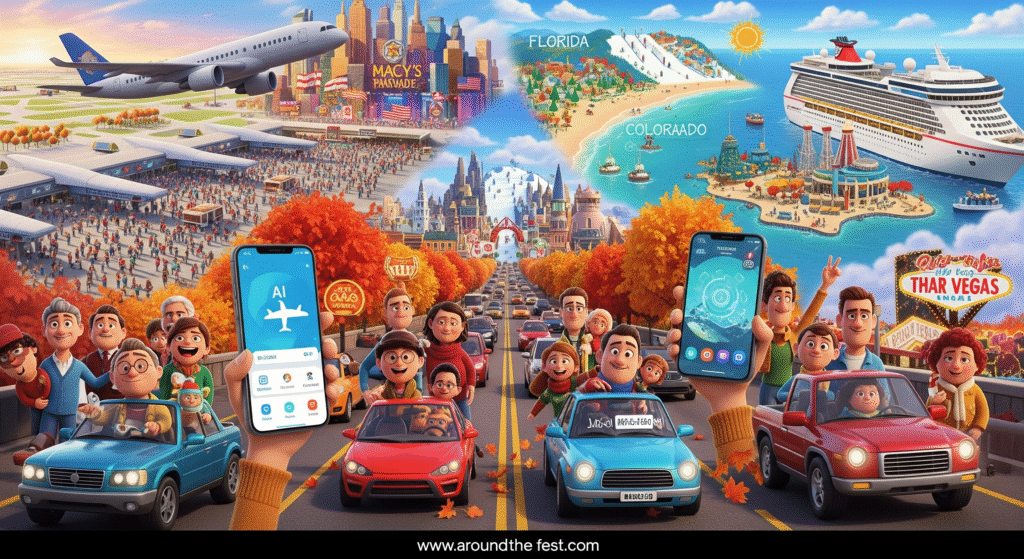
In the United States, Thanksgiving weekend consistently tops the charts for travel, with millions flying, driving, and boarding trains to see loved ones or enjoy short getaways. In 2025, navigating this bustling travel season has become increasingly sophisticated, combining tradition with technology.
Flights & Airports
Thanksgiving Eve remains one of the most crowded travel days of the year. Airlines are preparing for record passenger numbers as more Americans mix family visits with leisure trips. Modern AI flight tools now help travelers monitor ticket prices, identify the best booking times, and plan trips more efficiently, making it easier to manage holiday schedules.
Road Trips
Highways swell as families drive to celebrate with loved ones across states. Long waits at tolls, congested interstates, and busy rest stops are common. Electric vehicle travel is becoming more practical, thanks to an expanding network of charging stations that make long-distance drives smoother for families opting for eco-friendly transportation.
Destination Thanksgivings & Tourism
Some households forego cooking at home and instead gather at vacation hotspots. From Florida beaches and Colorado ski resorts to Caribbean cruises featuring special Thanksgiving menus, options abound. Popular destinations like New York City, with its famous Macy’s Parade, Orlando’s family theme parks, and Las Vegas with holiday packages, attract visitors seeking both reunion and adventure.
Tech-Savvy Travel
Digital tools now play a major role in Thanksgiving travel. Real-time traffic updates, AI-powered flight alerts, and smart booking platforms allow travelers to navigate peak congestion and last-minute changes more effectively, blending convenience with tradition.
Whether by plane, car, or cruise, holiday travel in 2025 demonstrates that Thanksgiving is about more than just the meal—it’s about the journey, the adventure, and the memories made along the way.
Virtual & Multicultural Thanksgiving in 2025
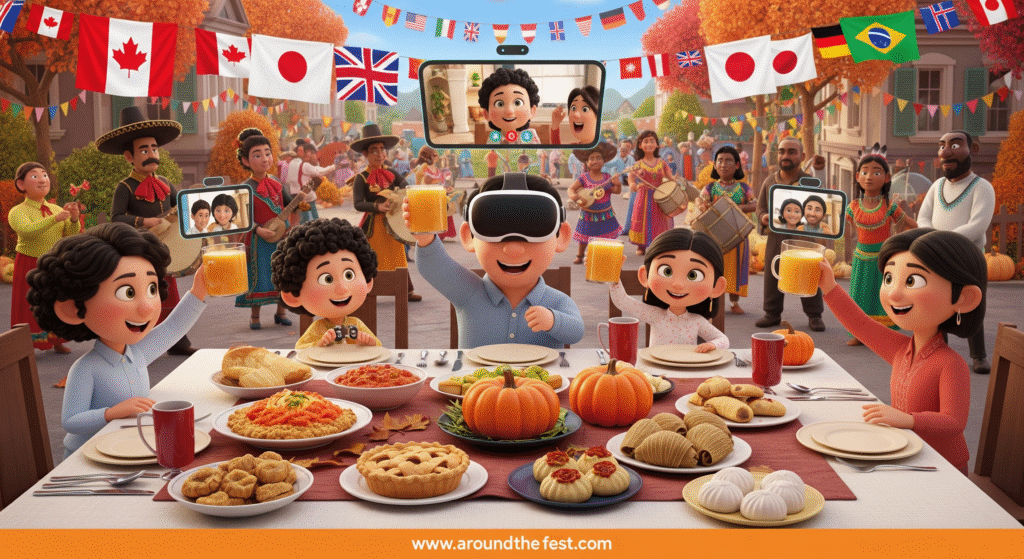
Thanksgiving in 2025 has transcended American borders, evolving into a global holiday of gratitude. Digital platforms and multicultural communities are reshaping how it’s celebrated, allowing families and friends to connect across distances.
1. Digital Thanksgiving Gatherings.
Families separated by distance or international borders join virtual feasts on Zoom, complete with synchronized toasts, online trivia games, VR dining experiences, and “digital dinner tables.” Viral TikTok challenges and livestream cooking classes add fun and cultural variety to the holiday.
2. Global Flavors at the Table
Menus now feature fusion dishes—Korean kimchi stuffing, Indian masala pumpkin pie, tamales, dumplings, or vegan/halal alternatives—reflecting America’s diverse cultural landscape.
3. Multicultural Parades & Celebrations
Cities like New York and Los Angeles showcase Thanksgiving events with Mexican mariachi, Caribbean steel drums, and Native American dances alongside the iconic Macy’s Parade. Beyond the U.S., communities in Canada, the UK, India, Japan, Germany, and Brazil host Thanksgiving-inspired events, often blending local customs with American traditions.
In essence, Thanksgiving 2025 is about widening the table, embracing global and cultural diversity, and making the holiday inclusive, digital, and culturally vibrant.
Emerging Thanksgiving Trends in 2025
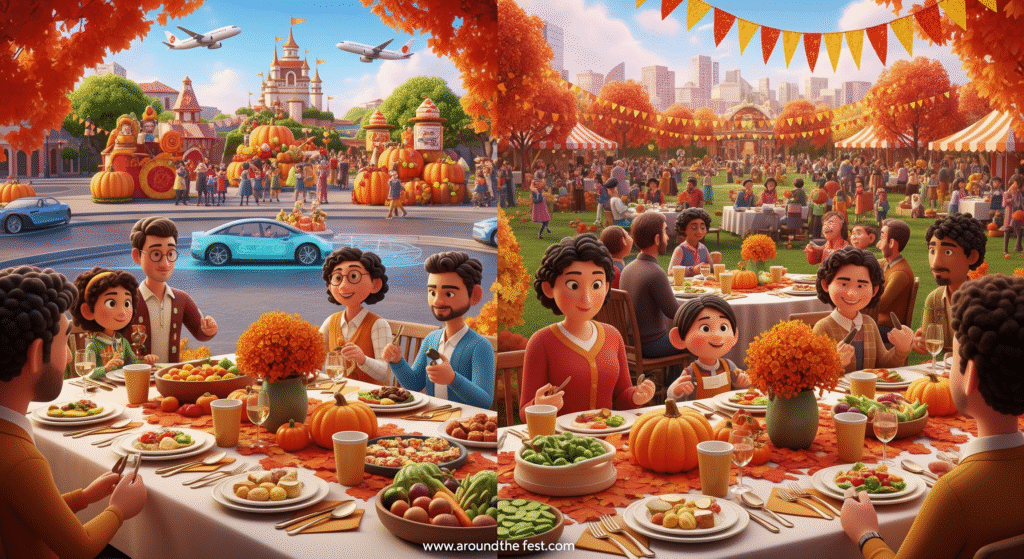
Thanksgiving traditions like turkey, parades, and family dinners aren’t disappearing—but in 2025, the way Americans celebrate is rapidly evolving. Modern families are blending sustainability, technology, wellness, sports, and multicultural flavors into their holiday rituals. Thanksgiving is no longer just about repeating the past; it’s about adapting to new lifestyles while keeping gratitude at the heart of the holiday.
Thanksgiving traditions like turkey, parades, and family dinners aren’t disappearing—but in 2025, the way Americans celebrate is rapidly evolving. Modern families are blending sustainability, technology, wellness, sports, and multicultural flavors into their holiday rituals. Thanksgiving is no longer just about repeating the past; it’s about adapting to new lifestyles while keeping gratitude at the heart of the holiday.
Here’s a look at the most exciting trends shaping Thanksgiving 2025:
Eco-Friendly Thanksgiving: Green Feasts & Zero-Waste Gatherings
In 2025, sustainability is taking center stage at the Thanksgiving table. Families are making eco-conscious choices:
- Zero-waste potlucks where every dish uses rescued or locally sourced produce.
- Composting food scraps and cooking with seasonal vegetables as part of meal prep.
- Reusable tableware and biodegradable decor, replacing single-use plastics.
Community initiatives in states like California and Oregon are promoting “Green Thanksgivings,” teaching families to celebrate while reducing their environmental footprint. Younger Americans are particularly embracing this trend, showing that gratitude extends beyond family to caring for the planet.
Thanksgiving Beyond the Dinner Table: Theme Parks & Public Feasts
Thanksgiving 2025 isn’t confined to dining rooms anymore. Families are exploring new ways to celebrate:
- Theme parks such as Disney World, Universal Studios, and Six Flags host Thanksgiving parades and food festivals with limited-edition treats.
- Major cities like New York, San Francisco, and Chicago offer community dinners in parks and churches for travelers, students, and locals who can’t join family.
- Destination Thanksgivings are on the rise—mini-vacations combining food, fun, and fireworks.
This trend turns Thanksgiving into a hybrid of travel, entertainment, and togetherness, far beyond the traditional home dinner.
Sports, Runs & Games: Expanding Beyond Football
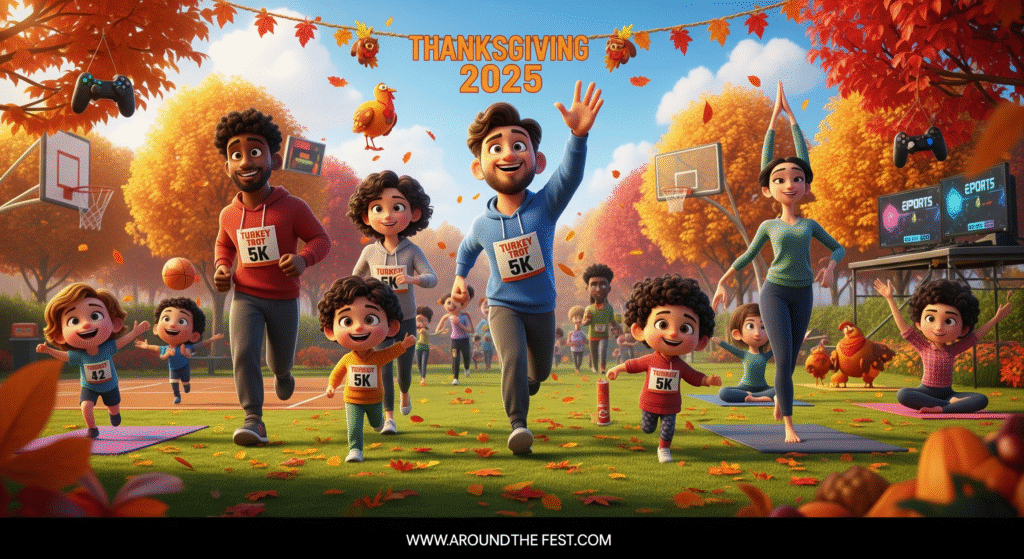
While NFL games remain a hallmark of the holiday, 2025 sees a broader sports culture:
- Turkey Trots (5K runs) are growing nationwide, giving participants a fun, fitness-focused way to “earn their feast.”
- Families organize backyard Olympics, basketball tournaments, and eSports competitions during the long weekend.
- Community fitness groups host Thanksgiving yoga sessions and wellness walks, offering healthier alternatives.
Sports are becoming more participatory, uniting families and communities while adding new energy to Thanksgiving.
Wellness & Mindful Thanksgiving

Post-pandemic lifestyles have heightened focus on mindfulness and presence during the holiday:
- Gratitude circles before meals, where each participant shares what they’re thankful for.
- Digital detox dinners, keeping phones out of the room to encourage real connection.
- Guided meditation, prayer, or mindful breathing sessions before the feast.
- Post-dinner yoga or outdoor gratitude walks, blending physical and emotional wellness.
Thanksgiving is shifting from pure indulgence to mindful celebration, emphasizing mental health and intentional connection.
Fusion Food & Global Flavors on the Thanksgiving Table
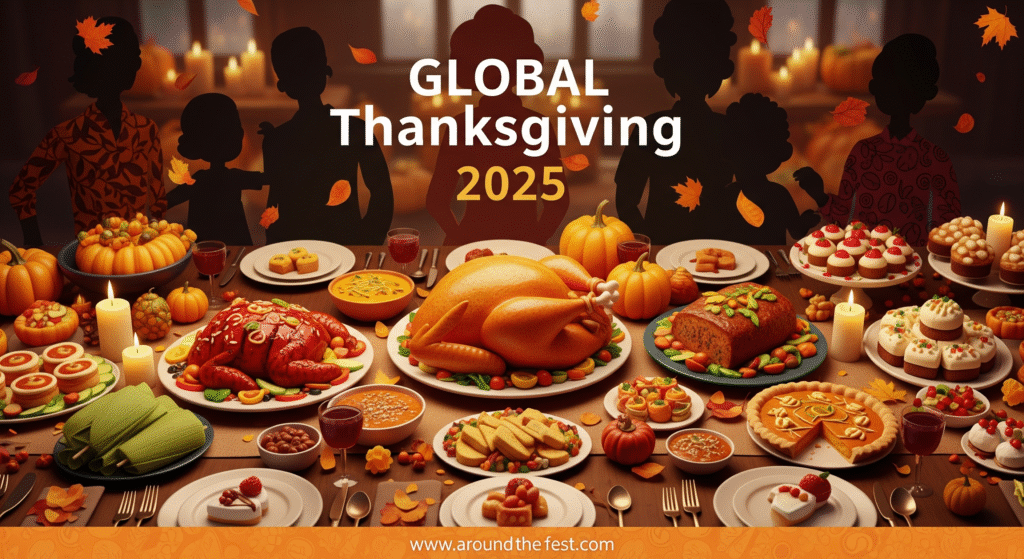
America’s cultural diversity is redefining Thanksgiving menus in 2025:
- Mexican-inspired turkey tacos and tamales
- Korean BBQ-style turkey
- Vegan or plant-based options, like mac & cheese with Indian spices or tofu roasts
- Globally inspired desserts, including Indian-spiced pumpkin pies and gluten-free stuffing
Food bloggers are dubbing 2025 the year of “Global Thanksgiving,” where multicultural dishes coexist with classic favorites, creating a truly diverse and inclusive table.
Tech & Smart Home Thanksgiving
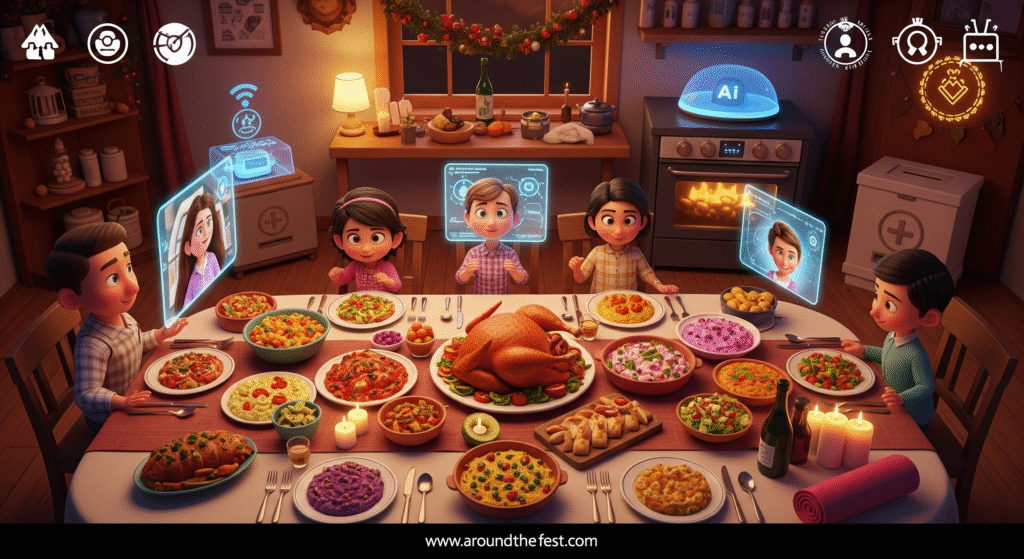
- Technology is transforming Thanksgiving into a connected, efficient, and interactive experience:
- AI-assisted cooking with smart ovens, meal-planning apps, and recipe trackers.
- VR “shared dinners” allowing distant family members to virtually join the table.
- Meal kits and food delivery services provide ready-to-cook options for hassle-free hosting.
Thanksgiving 2025 blends traditional celebration with cutting-edge technology, making it easier than ever to bring people together.
Philanthropy & Giving Back
Many modern families are combining gratitude with social responsibility:
- Volunteering at soup kitchens or food banks is increasingly popular.
- “Friendsgiving for a Cause” sees college groups and community organizations pairing potlucks with charity drives.
This shift emphasizes that Thanksgiving is about both giving thanks and giving back.
Regional & Cultural Twists
American Thanksgiving is more diverse than ever:
- Southern BBQ turkeys bring smoky flavors to the table.
- California favors vegan-friendly spreads.
- New York & New Jersey often mix Italian-American dishes into the feast.
These regional and cultural twists highlight how the holiday has become a celebration of diversity and creativity.
These trends show that Thanksgiving in 2025 is far from one-size-fits-all. Whether celebrating eco-friendly feasts, tech-assisted meals, Turkey Trots, wellness rituals, virtual gatherings, or fusion cuisines, the holiday reflects modern America’s culture, values, and creativity. Thanksgiving has evolved into a living, adaptive tradition, balancing heritage with innovation, gratitude with global connection.
The Future of Thanksgiving: What Could It Look Like by 2030?
Thanksgiving has always evolved with the times—from colonial feasts to televised parades to digital gatherings. But what might it look like just a few years from now? Here are some exciting predictions for the Thanksgiving of the future:
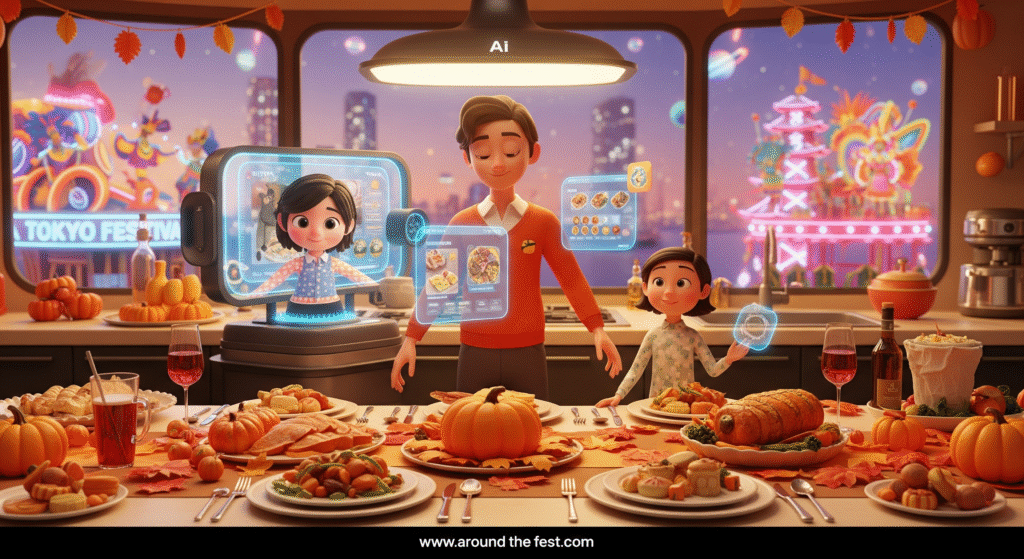
AI-Powered Kitchens
By 2030, smart kitchens could prepare entire feasts with minimal human effort. Imagine an AI assistant adjusting turkey roasting times, suggesting multicultural fusion recipes based on family heritage, and even projecting holographic cooking demos right on your countertop.
Sustainability-First Feasts
With climate change awareness rising, more families will swap factory-farmed turkeys for lab-grown meats or plant-based roasts. Zero-waste cooking, compostable packaging, and locally sourced produce could become the new normal for Thanksgiving tables.
Global Thanksgiving Festivals
As the holiday gains popularity abroad, we may see public Thanksgiving festivals in major cities worldwide—Tokyo hosting a parade with Japanese drummers and turkey floats, or São Paulo adding samba flair to the tradition.
Thanksgiving in Space
With space tourism expanding, who’s to say astronauts won’t host the first Thanksgiving on Mars or the Moon? NASA already sends turkey dinners to astronauts aboard the ISS—by 2030, a “cosmic Thanksgiving” could be live-streamed for all to watch.
Augmented Reality (AR) Gatherings
Families may soon slip on AR glasses and see holographic relatives “sitting” at their table, no matter where in the world they are. Imagine clinking virtual glasses with your cousin in London or playing a 3D football game with your uncle in Texas.
In essence, Thanksgiving’s future will stay true to its roots—gratitude and togetherness—while embracing bold new technologies, sustainability, and cultural fusion. The holiday will continue to remind us that no matter how far apart we are, there will always be a way to gather and give thanks.
Conclusion – The Spirit of Thanksgiving Day 2025 USA History Traditions
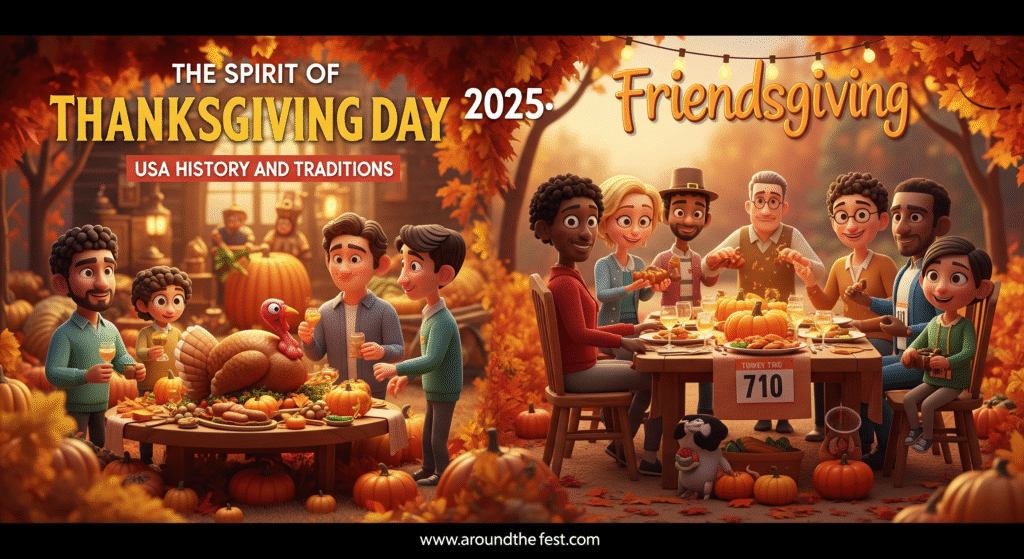
Thanksgiving Day 2025 USA history traditions remind us that this beloved holiday is more than just a feast—it’s a celebration of gratitude, family bonds, and shared community. From the first harvests in 1621 to today’s Friendsgiving gatherings, eco-friendly feasts, and multicultural menus, Americans continue to honor the past while embracing new ways to celebrate.
This year, the holiday reflects both time-honored customs and evolving practices, including digital gatherings, inclusive menus, and wellness-focused traditions. Whether enjoying a classic turkey dinner or participating in a Turkey Trot, the core of Thanksgiving Day 2025 USA history traditions remains the same: connecting with loved ones, giving thanks, and appreciating the abundance around us.
Ultimately, Thanksgiving Day 2025 USA history traditions are a living story—one that blends centuries of American heritage with modern creativity. It stands as a festival of thanks, a holiday of gratitude, and an American harvest holiday that continues to unite communities across the nation.
FAQs About Thanksgiving Day 2025 in the USA
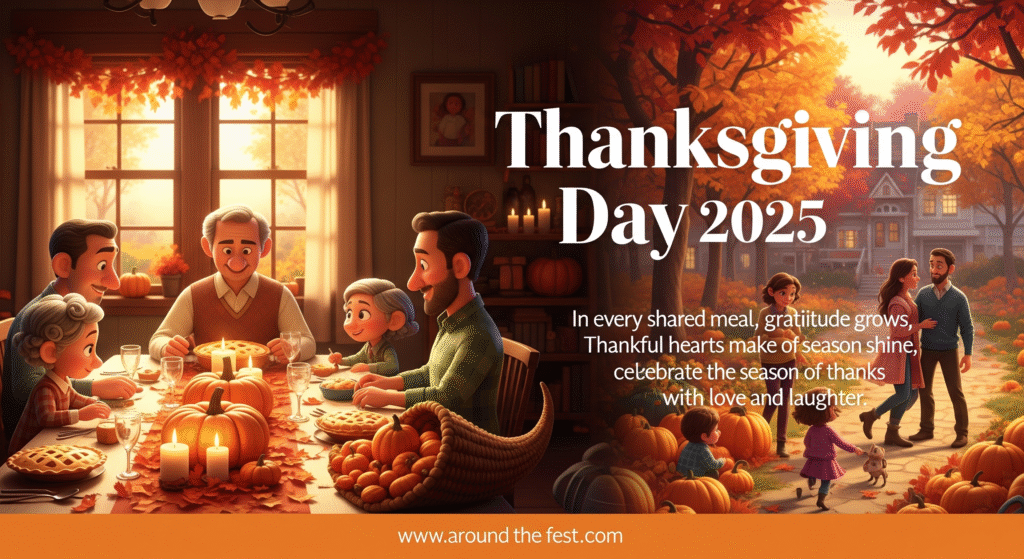
Q1. When will Thanksgiving Day 2025 be celebrated?
Ans. In the USA, Thanksgiving Day 2025 falls on Thursday, November 27, 2025.
Q2. Why do Americans celebrate Thanksgiving?
Ans. Thanksgiving originated in 1621 as a harvest festival shared by Pilgrims and Native Americans. Today, it is a holiday focused on gratitude, family, and longstanding traditions.
Q3. What are the most popular Thanksgiving foods in the USA?
Ans. Traditional favorites include roast turkey, stuffing, mashed potatoes, cranberry sauce, and pumpkin pie. Each region often adds its own distinctive dishes to the mix.
Q4. How is Friendsgiving different from Thanksgiving?
Ans. Thanksgiving is the classic family-centered holiday, whereas Friendsgiving is a modern, informal celebration with friends, usually held before or after the official Thanksgiving Day.
Q5. What are some key Thanksgiving traditions in the USA?
Ans. Popular traditions include family feasts, watching the Macy’s Thanksgiving Day Parade, enjoying football games, and volunteering to help the community.
Q6. Is Thanksgiving celebrated outside of the USA?
Ans. Yes, countries such as Canada, Liberia, and some Caribbean islands have their own Thanksgiving celebrations, though the American version is the most widely known internationally.
Q7. How busy is travel during Thanksgiving in the USA?
Ans. Thanksgiving weekend is the nation’s peak travel period, with millions traveling by car or plane to reunite with family and loved ones.

